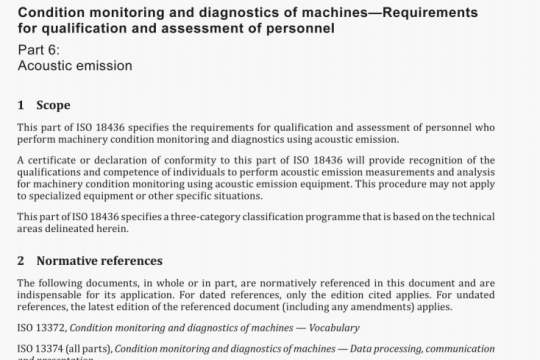ISO 34-1:2015 pdf free
ISO 34-1:2015 pdf free.Rubber, vulcanized or thermoplastic – Determination of tear strength
Means shall be provided for clamping the test piece firmly, especially in the region where the nick is to be introduced. The cutting tool, consisting of a razor blade or similar blade, shall be clamped in a plane perpendicular to the major axis of the test piece, and positioned so as to introduce the nick in the appropriate place. The blade clamping device shall permit no lateral movement and shall be fitted in guides to enable the blade to be moved across the test piece with its edge remaining perpendicular to the plane of the test piece. Alternatively, the blade shall be fixed and the test piece arranged to move in an analogous manner. Means shall be provided for fine adjustment of the depth of the nick. The adjustment of the position of the blade holder or clamped test piece shall be determined for each blade by cutting one or two preliminary nicks and measuring these with the aid of a microscope. The blade shall be wetted with water or soap solution prior to nicking.
NOTE A suitable apparatus for nicking tear test pieces has been described in detail in the literature.[6]
To check that the depth of the nick is within the specified limits (see7.4), any suitable means may be used, e.g. an optical projection apparatus. A convenient arrangement is a microscope giving at least 10 × magnification fitted with a travelling stage suitably luminated. The eyepiece is fitted with a graticule or crosswire by which to record the travel of the stage and test piece through a distance equal to the depth of the nick. The travel of the stage is calibrated with a stage micrometer.
Alternatively, a travelling microscope may be used.
The apparatus shall have an accuracy of measurement of 0,05 mm.
The machine shall conform to the requirements of ISO 5893, to an accuracy corresponding to class 1.
It shall be capable of registering the applied forces within 1 % during the test while maintaining the specified constant rate of separation of the jaws of 100 mm/min±10 mm/min for the trouser test piece and 500 mm/min±50 mm/min for the angle and crescent test pieces. A low-inertia machine having autographic force-recording facilities is essential when using the trouser test piece.
The machine shall be provided with a type of grip which tightens automatically as the tension increases and exerts a uniform pressure across the widened end of the test piece. Each grip shall incorporate a means for positioning so that the test pieces are inserted symmetrically and in axial alignment with the direction of the pull. The depth of insertion shall be such that the test piece is adequately gripped, within the parallel-sides portion, when testing angle and crescent test pieces. Trouser test pieces shall be inserted in the grips in accordance with Figure 4.ISO 34-1 pdf download.




